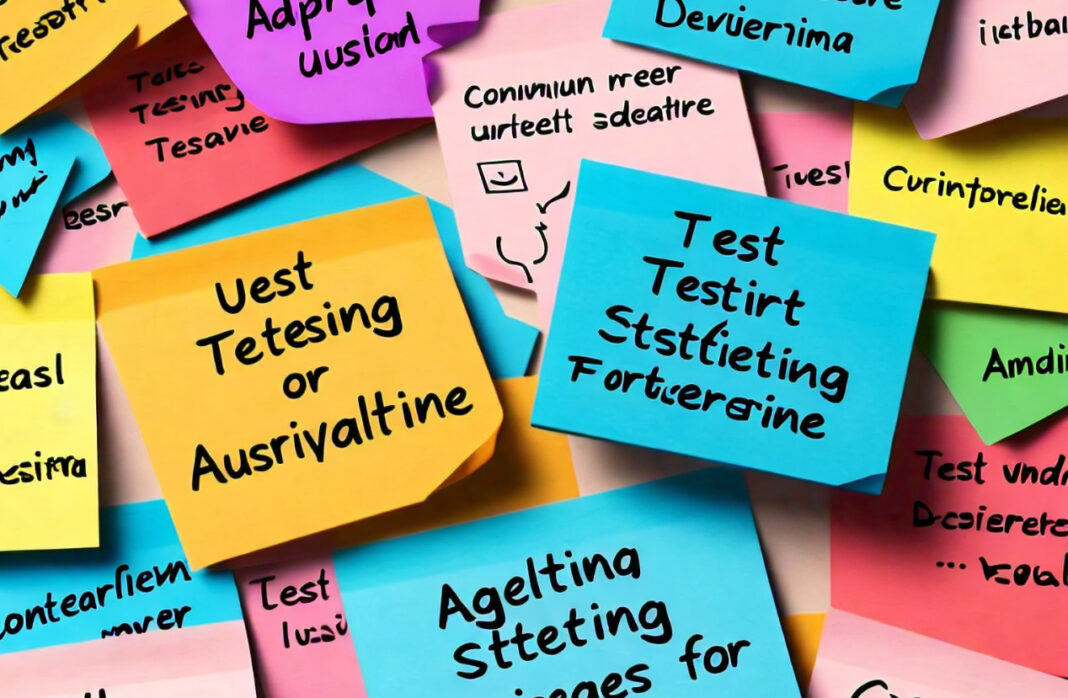Agile leadership has become quite important in today’s fast-moving and highly dynamic business environment for an organization to stay ahead. Much more than emulating Agile methodologies, it represents the fostering of a culture of readiness, cooperation, and continuous improvement. The article details the principles and practices of leading in an agile environment and what leaders can do to inculcate a culture of working together that ensures success.

Definition of Agile Leadership
Agile leadership represents a state of mind and a mode of operation that adheres to core values and
principles that undoubtedly underlie Agile methods. It emphasizes adaptability, collaboration, and
focus on value to the customer. Compared to leadership models applied traditionally, which usually
rely on hierarchical structure and command-and-control methods, Agile leadership promotes a more
respective and empowering atmosphere.
Core Principles of Agile Leadership
- Servant Leadership: Agile leaders treat themselves as servants to their teams. The work of a leader
is to support, empower, and facilitate the success of the members, not to dictate activities. - Empowerment: Leaders let their teams decide as much as possible at the lowest possible level by
freeing them up and giving them authority. This enables quick responses to change and innovation. - Collaboration: Agile leaders ensure that there is an enabling environment to ensure everybody
pulls together towards the common goal. They consider collaboration as a driver of success and
innovation. - Continuous Improvement: Agile leaders promote a culture of continuous learning and
improvement. They develop experimentation and can learn from failures.

Creating a Collaboration Culture
1. Communication Open:
Open and transparent communication forms the basis of a collaborative culture. In following
this, agile leaders encourage team members to share their ideas, feedback, and concerns. This could
happen in several ways, among them, during regular team meetings or in the feedback sessions as
part of a retrospective.
- Regular Check-ins: Have daily stand-ups or weekly meetings where everybody can align and
know each other’s progress and challenges. - Feedback Loops: Practice regular feedback loops so that teams can always get constructive
feedback and give some as well to improve the working culture.
2. Foster Cross-Functional Collaboration:
Cross-functional collaboration means there should not be any silos. Members from every
background should be allowed to work on different tasks. Agile leaders should promote cross-
functional opportunities for teams to work collectively across functions and use various
perspectives. - Cross-Functional Teams: It brings together a group of cross-functional teams composed of
various departments or skills. The purpose of this is to improve collaboration and help with the problem–
solving. - Shared Goals: Shared goals and objectives help in aligning team members and lead to
collaboration towards a common objective.
3. Safe Environment:
A safe environment is one in which a person can take risks, make mistakes, or express opinions
without running the risk of being ensnared. Agile leaders should work hard to establish and cultivate
the following:
- Psychological Safety: Encourage a culture where people feel safe to express their ideas and
concerns. This means a genuine interest in listening and responding with empathy. - Fail Fast, Learn Fast: Make a big deal out of learning from failure and how to iterate quickly.
This shifts the fear of failure and motivates experimentation.
4. Acknowledge and Celebrate Successes:
Recognizing and celebrating each success — big or small — brings about morale and defines
collaboration further. Agile leaders should acknowledge individual and team achievements regularly.
- ** Celebration Rituals:** Bringing in rituals or practices that celebrate an accomplishment, be it
through something like a team lunch or kudos in a meeting, really helps in keeping the tone of your
culture positive. - ** Recognition Programs:** Create programs or mechanisms for contribution acknowledgment
that will motivate and create a basis for interaction for the members of the team.
Empower Teams
1. Autonomy:
Empowered teams are those given the leeway to make decisions concerning what to do and take
ownership of the deliverable. What agile leaders need to learn is how to stop managing the team’s
effort by depriving them of decision-making.
- Decision Making Responsibility: Allow the team to make decisions regarding their work, and
empower them to take ownership of the outcome. This will give them a sense of responsibility
and, eventually, accountability. - Supportive Leadership: Resources and support should be provided wherever needed, but
without telling the ways and means for task completion. Trust in the capability and potential of
teams to come out with the best output they can with their current knowledge.
**2. Availability of Resources and Help:
While autonomy is important, it is equally necessary for teams to have access to appropriate
resources and support. Agile leaders should ensure that all available resources for the performance
of the team are availed to them.
- Training and Development: Invest in the training and development of skill sets among team
members for their roles, relevant to the changing trends in the industry. - Tools and Technology: Make tools and technology available that would support teams in
collaboration and hence ensure high-quality work delivery.
3. Encourage Professional Growth:
Agile leaders must encourage the professional growth of their team members and avail opportunities
for career attainment through the enhancement of their competencies.
- Mentoring and Coaching: Offer mentoring and coaching to help team members develop their
skills in achieving their career goals. This may include one-on-one meetings, career development
planning sessions, and workshops on building specific skills. - Career Pathing: Work together with the team members in identifying any possible career
pathing and advising them on how to realize their career aspirations.
Leading by Example
**1. Displaying Agile Values
Agile leadership will be described by them showing model behavior, characterized by values and
principles of Agile methodologies — transparency, collaboration, and commitment to continuous
improvement.
- Transparency: All critical information and events must be shared with either your team or the
organization. These might include goals, problems, and changes that will affect them. This will help
put in place an environment of trust and cooperation where there is open sharing. - Collaboration: Be involved in the activities around your team. Collaborate with team members
to solve problems and achieve objectives that are the team’s requirement.
2. Embracing Change:
Agile leaders will never be afraid of change; on the contrary, they perceive it as the possibility of
development and improvement. It mentally gives a core attitude inside the team toward
adaptability.
- Adaptiveness: Stay open to new ideas or new approaches, and let your team experiment and
iterate. This will lay the foundation for a culture of innovation and continuous improvement. - Positive Attitude: Carry the right attitude and demonstrate that change or uncertainty, in
whatever form it takes, can be handled with a positive attitude. Help your team work through issues.
3. Modeling Continuous Learning:
An Agile leader should model a resolution for lifelong learning and improvement. By doing so, one
would solicit feedback, reflect on performance, and look for opportunities for growth through
learning.
- Personal Development: Be invested in your professional development through things like
attending trainings, meeting with people to get feedback on your development areas, and staying
relevant to the changing times. - Reflective Practice: Keep reflecting on the practices of leadership, ways to improve, and seek
inspiration. This will further help you set a demonstration for growth and, in turn, inspire your team.
Challenges in Agile Leadership:
1. Resistance to Change:
Amongst the common Agile Leadership challenges where change has been put up against resistance.
The team members and the stakeholders are already habituated to some formal way of working.
- Addressing Resistance: Engage faced resistant people. Identify what worries them, and act on
it before it occurs. Show the benefits of doing Agile and make them part of the change process. - Building Support: Ensure support for agile methods by showing their success and value
through the application of small pilot projects. - Balancing Autonomy and Accountability:
It all offers the challenge of finding the balance between autonomy and accountability. On the one
hand, teams should be free to make decisions, while, on the other, they must be held accountable for
the outcomes.
- Set clear expectations around performance and outcome but give the teams autonomy on how
to achieve these. - Regular Check-ins: Regularly check in on progress and provide any support needed. This
keeps teams accountable while remaining autonomous.
3. Keeping in Line:
Too much autonomy can at sometimes lead to a lack of alignment with organizational goals and
priorities. Agile leaders need to ensure that the teams are on the right track with what matters:
delivering value and objectives of a strategic nature.
- Alignment Mechanisms: Establish mechanisms like regular alignment meetings, shared goals,
and transparent communications that keep teams aligned with organizational priorities. - Cross-team coordination: Help teams coordinate and collaborate to ensure
alignment of efforts in service of organizational goals.
Conclusion
Agile leadership is very fundamental to driving great success within an organization by facilitating a
circle of collaboration. In such a manner, by allowing open channels of communication, encouraging
joint functional collaboration, securing a safe environment, and empowering teams, agile
leaders can build a culture that allows innovation and continuous improvement.
Agile leaders, who authentically adhere to Agile principles, inspire their teams just by leading them from the front to work cohesively to achieve shared goals, face changeability, and exemplify remarkable performance. Although Agile teams may suffer from naturally challenging factors, such as resistance to change or the necessity for balancing autonomy with accountability, Agile leaders can overcome them by applying proactive strategies and maintaining a commitment to continuous learning and improvement.
It is a continuous effort on the part of Agile leadership to create such an environment where the team feels valued, supported, and motivated to give the best. Only in this way can an organization leverage the full potential of its teams to ensure success in the very dynamic and competitive
landscape.






